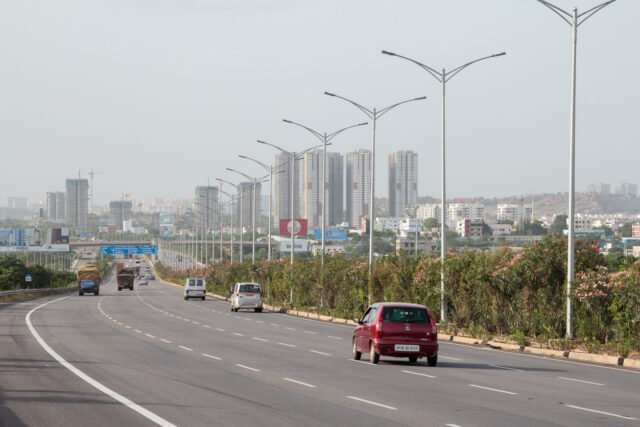The state government insists on developing both corridors simultaneously to maximize the RRR’s utility. A delay in the southern corridor until the northern segment’s completion in 2026 could escalate land acquisition costs significantly

Hyderabad regional ring road: One half ready for construction while the other awaits central clearance (iStock)
Synopsis: The 340-km Hyderabad Regional Ring Road (RRR) project is set to begin, aimed at easing traffic, boosting connectivity, and spurring economic growth. The northern corridor—covering 161 km at ₹9,500 crore—is ready for construction, while the southern segment has received state cabinet approval. NHAI will execute the project, with the Telangana government sharing 50% of land acquisition costs
The construction of Hyderabad Regional Ring Road (RRR), a 340-kilometre, six-lane expressway around the 158-km Nehru Outer Ring Road (ORR), is all set to begin.
Designed to ease transportation challenges, enhance regional connectivity, and drive economic growth, the RRR is expected to solve Hyderabad’s growing traffic congestion while fostering development in surrounding areas.
The northern corridor is ready for construction and the southern corridor has recently been approved by the state cabinet.
The northern segment, spanning 161 kilometers and estimated at ₹9,500 crore, connects Sangareddy, Narsapur, Toopran, Gajwel, Jagdevpur, Yadagirigutta, Bhongir, and Choutuppal. The National Highways Authority of India (NHAI) is overseeing the project, with the Telangana government funding 50 percent of land acquisition costs.
According to official sources, tenders for northern segment were issued on 28 December, 2024, with 20 firms bidding to develop the Detailed Project Report (DPR). Approximately 48 percent of the required 1,785.5 acres land has been acquired, with compensation disbursed to farmers in Yadadri and Medak districts.
The northern corridor is on track for completion by next year. This is part of the broader plan to integrate 11 radial roads connecting the ORR and RRR. At a review meeting recently, Chief Minister A Revanth Reddy said: “These radial roads would be helpful for spurring industrial growth.”
The southern segment, covering 182–189 kilometers at an estimated ₹6,480 crore, links Choutuppal, Ibrahimpatnam, Kandukur, Amangal, Chevella, Shankarpally, and Sangareddy. On 23 June, 2025, the Telangana state cabinet approved one of three proposed alignments, selecting the option with 99 percent agricultural land to simplify acquisition and avoid forest land issues.
Also Read: KTR takes up Chief Minister Revanth Reddy on debate challenge
Recent updates
The official sources said that the Detailed Project Report (DPR) is under preparation and expected by year-end, with the alignment revised from 150 km to 182 km to enhance connectivity. On 11 March, 2025, Roads & Buildings Minister Komatireddy Venkat Reddy met Union Minister Nitin Gadkari, securing assurances for environmental clearances and a tripartite financial agreement. Komatireddy affirmed, “Our target is to complete the RRR within three years.”
Land acquisition has begun, with 12 percent of the required land secured. Komatireddy emphasised collaboration, stating on 22 May, 2025: “The state government is working in coordination with the National Highways Authority of India (NHAI) for obtaining approvals and financial support from the Centre.” The southern corridor awaits final approval from the Ministry of Road Transport and Highways (MoRTH) due to sustainability concerns, as traffic studies indicate fewer than 6,000 vehicles per hour.
The southern corridor is projected for completion by 2027–2028, with efforts to fast-track approvals. Komatireddy highlighted its transformative potential, calling the RRR a “super game changer” for Telangana at a media interaction recently.
The RRR, positioned 30–50 kilometers beyond the ORR, will connect 17 national and state highways, including NH-65, NH-44, NH-163, and NH-765, and over 125 villages across Rangareddy, Bhuvanagiri, Siddipet, Medak, and Sangareddy districts.
With the ORR’s traffic density nearing saturation point at one lakh vehicles per day due to Hyderabad’s rapid growth in pharma, IT, logistics, and industrial sectors, the RRR is becoming critical for decongesting traffic. Chief Minister A Revanth Reddy had outlined its broader goals recently stating: “The state government wants to transform Hyderabad region into a global economic hub. The RRR will play a key role in it. As industrial and technology zones come up, regional connectivity for trade and logistics becomes easier.”
A step towards the future city initiative
The project also intends to support Telangana’s Future City initiative along Srisailam Highway and integrated townships in Amangal and Toopran. Real estate experts predict a 10–20 percent surge in property demand in Sangareddy, Shankarpally, Bhongir, and Gajwel, with the RRR boosting logistics, manufacturing, and IT sectors. The state has allocated ₹1,525 crore in the 2025 budget to support land acquisition, with the central government funding construction costs.
The state government insists on developing both corridors simultaneously to maximize the RRR’s utility. A delay in the southern corridor until the northern segment’s completion in 2026 could escalate land acquisition costs significantly. Revanth Reddy urged proactive coordination, stating, “If the issues are not resolved within the state, then the ministers should go to Delhi and discuss the matters with the Union government,” to effect timely clearances.
While the northern corridor secured environmental clearance on 18 March, 2025, the southern corridor faces land acquisition concerns. The government is addressing them through transparent acquisition processes to mitigate community resistance, official sources said.
(Edited by Ananya Rao)








